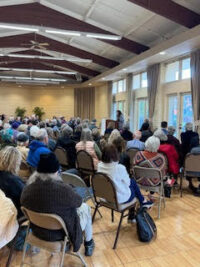The acclaimed Measure E parcel tax for the public schools in Sonoma Valley was defeated by voters Tuesday evening. Most observers were caught off guard by the results.
Of the 7,090 votes cast by mail before November 6, it was 55.5% yes and 44.5% no.
Of the 2,281 votes cast at the polls on Election Day, it was 61.8% yes and 38.2% no.
Altogether 9,371 ballots were cast, of which 57.0% were yes and 43.0% no.
The campaign was run by San Francisco political consultant John Whitehurst, at a cost of about $20,000 in fees and $100,000 in expenses. It was designed as a targeted voter campaign, with no billboards, yard signs, bumperstickers or newspaper advertising.
This strategy is reminiscent of the 2004 campaign for an $85 parcel tax, which also used a stealth approach and focused on telephone calls to targeted voters. Some 13,738 votes were cast in that election, of which 62.3% were yes and 37.7% no.
All of the funds were privately raised to finance the Measure E campaign; nothing was paid by the school district itself, according to district officials. School parent Laura Zimmerman was head of the Friends of Measure E campaign. While obviously disappointed the measure did not pass, Zimmerman noted that the 57% approval received would be considered a landslide in, for instance, a presidential election, while the 66.7% supermajority required to pass a tax measure in California can be difficult to achieve. Zimmerman especially noted the contributions of hundreds of student, parent, and teacher volunteers who helped with the campaign and participated in the several telephone banks used to contact voters.
The school district now will have to cut out of next year’s budget (2008-009) some $1.2 million. Superintendent Barbara Young said, following the announcement of the election results, that she would have to begin that process right away, probably recommending to the board of trustees at its next meeting, November 13, that a “stakeholder” committee be formed, to develop recommendations for the board to accomplish the cutbacks needed to preserve balanced financial statements, as required by the state.
Measure E School Tax soundly defeated
More from What's HappeningMore posts in What's Happening »
- Lighted Tractor Parade Set for November 30 on Sonoma Plaza
- Creative Sonoma Announces #TeachTheArts Campaign to Boost Local Teaching Workforce
- The Living Legacy of Mac McQuown
- “Community Call to Action Town Hall” Draws Concerned Residents
- Sonoma Youth Receive American FFA Degrees
- Margaret Hatcher Named 2025 Treasure Artist






